The NVIDIA SHIELD Android TV Review: A Premium 4K Set Top Box
by Ganesh T S on May 28, 2015 3:00 PM EST- Posted in
- Media Streamer
- Home Theater
- TV
- 4K
- Shield
- NVIDIA
System Performance
From an editorial perspective, the SHIELD Android TV may be one of the most frustrating devices we’ve worked on in recent history. Simply put, the Android TV market is still a tiny market. Google’s Nexus Player is most of the market right now, and only very recently have other Android TV devices such as the Forge TV and SHIELD Android TV reached the market.
As a result, figuring out what to compare the SHIELD Android TV to and how to present it has been an interesting challenge. A set top box is not a mobile device, and while they share similar OSes and the same families of SoCs, that does not make them identical devices. At the same time however, if we restrict ourselves to just Android TV devices, it would be a very limited and uninteresting comparison. The Nexus Player is a quad-core Intel Atom, but only includes 1GB of RAM, among other limitations.
Ultimately it’s clear that the SHIELD Android TV is heavily overspeced compared to other Android TV devices – no one else is pursuing this premium market – so instead we’re going to focus on looking at benchmarked performance relative to the newest generation of SoCs in the latest iOS and Android tablets. This is by no means a fair matchup and we need to be clear about this – the SHIELD Android TV has no throttling or power constraints, no need to balance out energy efficiency – but it at least gives us some idea of how the device and Tegra X1 compare to other products. Just don’t expect to see a Tegra X1 tablet perform this well. And in the meantime, some of the results may surprise you.
As always for an Android device review, we'll start off with our browser benchmarks. SHIELD Android TV doesn’t actually ship with a browser – we had to sideload Chrome – but these are among our most flexible benchmarks and help put performance in context of more than just Android devices.
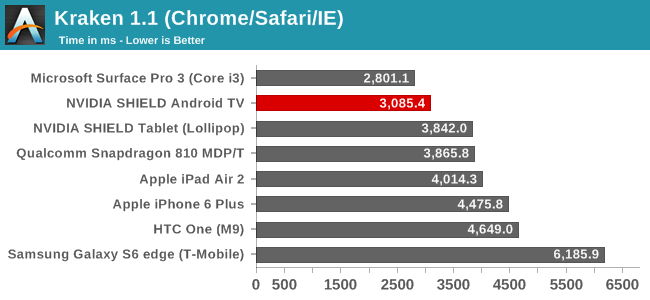
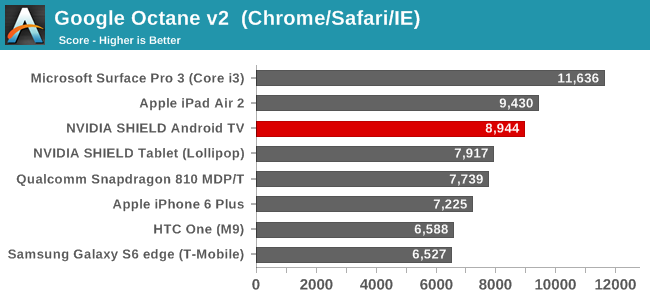
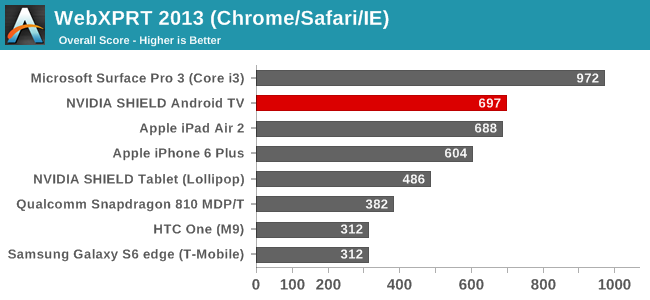
Among Android devices, the SHIELD Android TV stands alone, as you’d expect. Without any throttling to hold it back, it leads over Tegra K1, Snapdragon S810, and Exynos 7420 over all 3 web benchmarks. That said, even with its unrestricted Cortex-A57 CPU cores, we also find that Apple’s A8X-based iPad Air 2 is a close match in Octane and WebXPRT, just edging out the SHIELD Android TV and being edged out respectively. Meanwhile for anyone curious how this compares to high-end x86 tablets like the Surface Pro 3, well even SHIELD Android TV isn’t quite up to par with those devices at this time.
Moving on, we have Basemark OS II 2.0, which should give a better picture of CPU performance in addition to overall device performance.
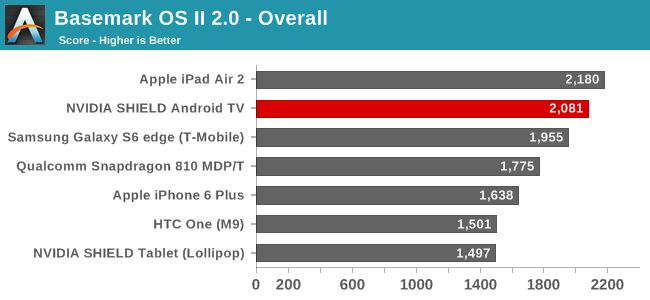

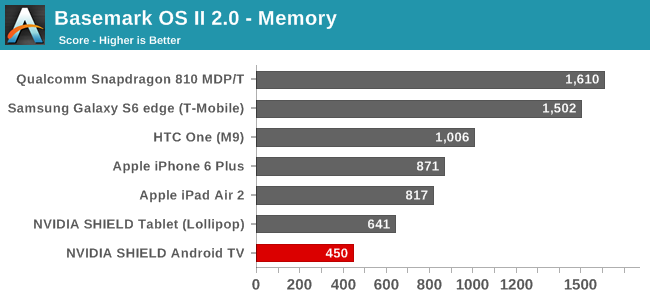
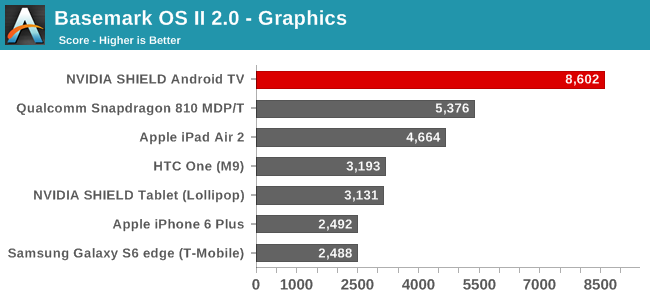
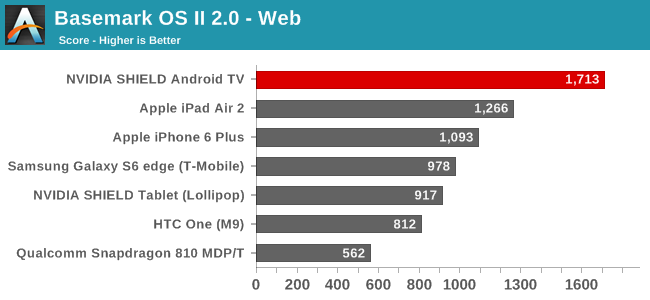
Overall, performance under Basemark still slightly favors the iPad Air 2. SHIELD Android TV easily takes the second spot, but it’s not enough to catch Apple’s tablet.
Looking at the subscores, we can see why this is. SHIELD Android TV only fares decently under the System test, but not well. The big surprise here is not the iPad, which always does well, but the fact that the SHIELD is so far behind the Galaxy S6, which features a similar CPU setup. As this sub-test pushes both the CPU and memory, we may be seeing something related to the implementation differences between Tegra X1 and Exynos 7420, or it may just be an Android TV-inspired difference.
However the memory score is particularly bad, coming in behind even the last-generation SHIELD Tablet. As this is a NAND test, what we're likely seeing is a consequence of the SHIELD's poor random performance, something we'll dive into a bit later in our detailed look at NAND performance.
On the other hand, graphics and web performance are outstanding. We had certainly expected the SHIELD to do well in graphics given what Maxwell is capable of – it is a graphics monster unlike any other current SoC – but the web test is a pleasant surprise. The combination of using Android TV’s built-in web view and the lack of any real throttling likely play a big part here, and although Android TV doesn’t ship with a standard web browser, this bodes well for any apps making use of web view and Javascript.
Our next system benchmark is PCMark, which does a number of basic benchmarks designed to stress various aspects of the device in everyday workloads like video playback, web browsing, text editing, and photo editing. This tends to test every aspect of a mobile device, unlike microbenchmarks that can often miss aspects of the system that can affect performance.
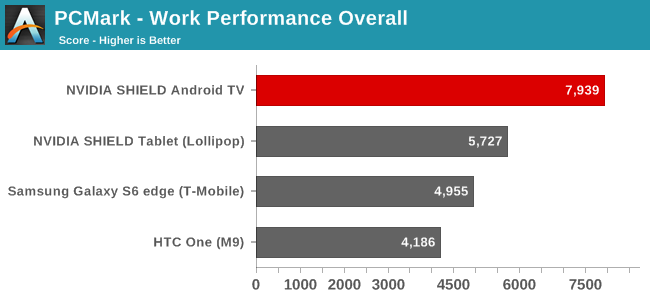
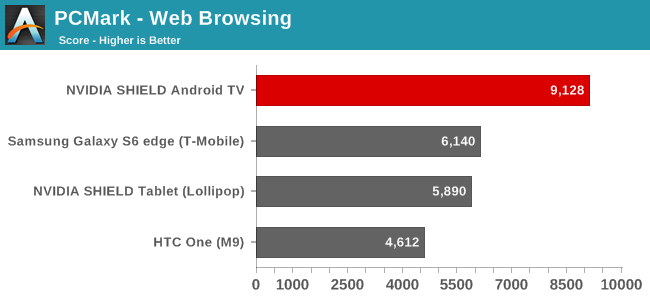

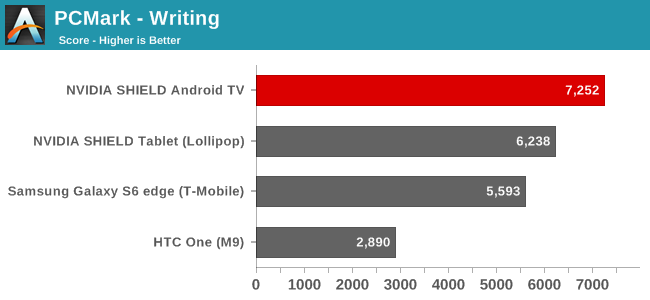
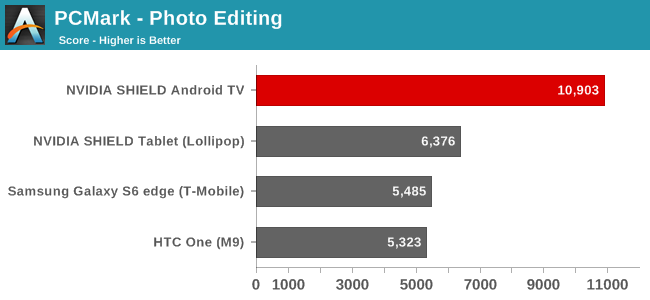
With the exception of the Writing subtest, where the SHIELD Android TV and second-place device are kind of close, PCMark is a runaway victory for the SHIELD Android TV. Once again we’re almost certainly seeing the benefits of the box’s aggressive performance since it doesn’t need to throttle down, or even be conservative on clockspeeds for power purposes. In which case it gives us an interesting look at what Cortex-A57 can do when not held back.
Overall, CPU/system performance is more or less what one would expect based on the design of the SHIELD. As a set top box with a quad-core A57 implementation under the hood and the cooling to let it run wild, SHEILD is frequently A57 at its best. Which means it’s going to easily surpass other A57 devices in most situations, but it also means that even with its unrestricted performance, Apple’s A8X processor and its tri-core “Enhanced Cyclone” CPUs still serve as a reminder of those times where A57 struggles against Enhanced Cyclone’s high-IPC design.
For our final look at system performance, let’s take a quick look at the SHIELD's built-in NAND performance with AndroBench 4.0.
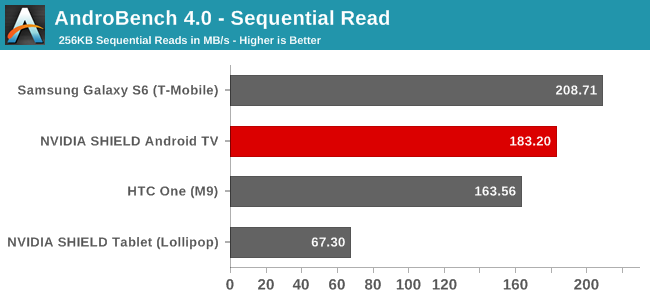
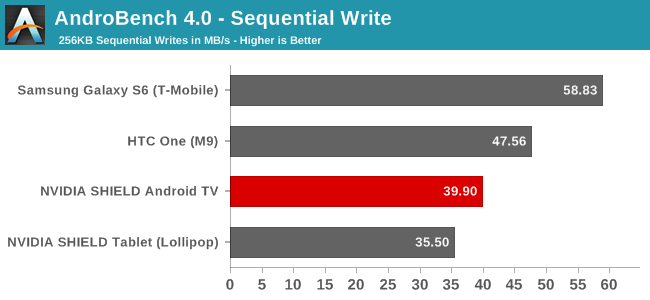
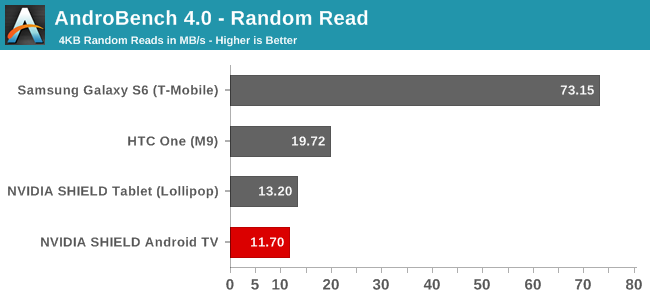
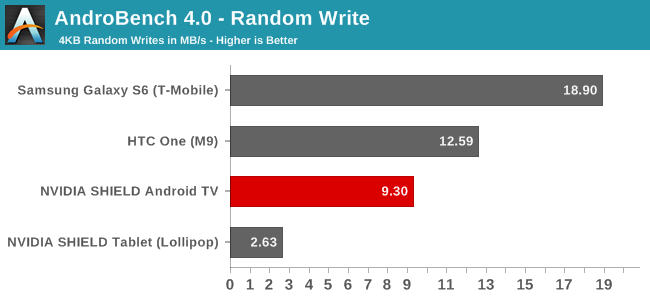
Update 5/28: AndroBench numbers have been revised to account for an error, sorry about that
Though we only have a few AndroBench 4.0 results compiled so far, it’s enough to paint a decent picture. For sequential reads the SHIELD’s built-in NAND fares relatively well. It’s not enough to top the Galaxy S6 and its UFS flash, but it’s keeping up with the pack. Sequential writes on the other hand aren't quite as good, with write performance ahead of only the SHIELD Tablet. Meanwhile random performance is a real mixed bag; the SHIELD Android TV is at the bottom of the random read chart - below even the SHIELD Tablet - while random write performnace is significantly better than the tablet, but still chasing the M9 and well off the S6.
Among Android flagship devices UFS definitely gives the Galaxy a big benefit here, but the SHIELD could stand to improve all the same. However I’m not sure how much that matters to NVIDIA, as the SHIELD is clearly designed to lean on external storage via microSD/USB for users who end up using it for storage-intensive needs such as gaming as opposed to basic set top box streaming.










167 Comments
View All Comments
Morawka - Thursday, May 28, 2015 - link
the chip and the wires (hdmi) have the necessary bandwidth, so shouldn't be a issue.Haydon987 - Thursday, May 28, 2015 - link
Shouldn't be in the case of dozens of currently existing devices, but in every case so far of any publicly available hardware I've seen, all encrypted content comes out 4:2:0 at 4k, so it would be nice for a vendor to acknowledge if it plays 4k hdcp 2.2 at 4:4:4 or just plays unencrypted stuff (like games, menus, ads, etc.) at 4:4:4 at 4k. Until a vendor specifically states it, I have my doubts. Sure all the features are listed to make it sound good to people who don't look too deeply into it, but they don't state when the features are interoperable.It's like a person listing for a spec sheet about themselves:
1. I can run 17 miles per hour
2. I can run 25 miles
This does not mean that this person can run 25 miles at 17 miles per hour. They are just 2 separately listed specs. Chances are they only maintain that speed for a few seconds.
In this case what is most likely:
1. I can play without color compression (4:4:4)
2. I can play protected content at 4k (hdcp 2.2), but I won't tell you if that is compressed or not.
ganeshts - Friday, May 29, 2015 - link
That is definitely an interesting question, but it is somewhat moot.. let me explain:Getting specs out of the way, the SHIELD does support RGB 4:4:4 at 4Kp60 on the HDMI port.
Now, all video content that consumers play back - Netflix or Blu-rays and the like - they are all encoded in 4:2:0 - In this case, the consumer has nothing to gain or lose whether the conversion to 4:4:4 is done on the source side or the sink side. So, HDCP 2.2 with just 4:2:0 support is fine.
On the other hand, for professional applications, where content is processed in 4:2:2 or even 4:4:4 format, it will be a problem - but, it is likely that the workflow process in that case doesn't involve protected content - the protection is applied / needed only on the consumer delivery side.
Again, this is an interesting aspect, and one that I will definitely be questioning HDMI source / sink vendors on. It is just that it doesn't matter for consumer applications.
457R4LDR34DKN07 - Thursday, May 28, 2015 - link
I'm interested in trying this with a hdhomerun prime with the live tv app. Does this android tv device support mpeg 2 decoding?457R4LDR34DKN07 - Thursday, May 28, 2015 - link
"The typical media library also includes TV programs that are interlaced MPEG-2 (for example). The SHIELD is currently not a good solution for such a case."Thanks, not for me then
Ryan Smith - Thursday, May 28, 2015 - link
The Live Channels app supports hardware MPEG-2 decoding, including deinterlacing. That functionality just isn't available to other media playback applications, since it was licensed for just the Live Channels app.DanCar - Thursday, May 28, 2015 - link
The recommendation row can be turned off partially or fully in settings -> System Preferences (3rd row) -> home screenYou can select which sources to enable and disable.
ganeshts - Saturday, May 30, 2015 - link
Somehow, I am not able to follow the path you are referring to..Under settings, I have Device > System, and under that nothing about Home Screen.. Do you have a video or set of screenshots showing the path?
I know that it is possible to go into the settings of a particular app and turn off the Notifications for that app - on Android TV, that turns off the 'Recommendations' - this is what I had done for the YouTube video showing the Android TV UI. The Recommendations row doesn't seem to have an option to turn it off completely..
BuddyRich - Thursday, May 28, 2015 - link
I was hoping they spent the money and licensed the codecs but no HD Audio or DTS (or MPEG2 or VC1) is a bummer. At least in the case of the video codecs the CPU is fast enough to decode in software. Will not replace my HTPC. Its funny they license them for their videocards, including their cheapest passive ones but not their premium set-top box. And the box doesn't even have to decode it, just pass it through to a receive, that shouldn't require a license at all.One thing that was unclear in your review though, if I use HDHomerun/Live TV app will it decode and deinterlace MPEG2 via hardware since the app is licensed? If so is this supported on Shield like it is on Nexus Player?
At least they shipped with working Netflix, unlike Razor.
webdoctors - Friday, May 29, 2015 - link
Why is a license needed if its just bit-streaming? If i connect it to my amp and my amp separates the hdmi video from the audio signals, why would the licensing matter on this box?